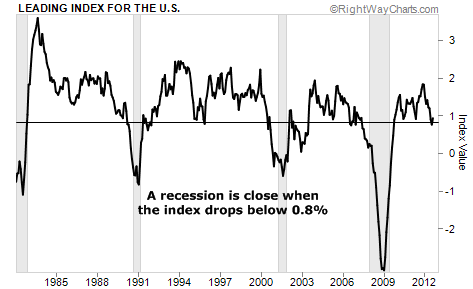| Home | About Us | Resources | Archive | Free Reports | Market Window |
What the Hard Facts Are Saying About a RecessionBy
Wednesday, November 7, 2012
Last month, I showed you concrete evidence that the U.S. economy is slowly getting better.
If you're not aware of this evidence, or simply deny that it exists, you could miss out on huge investment opportunities over the coming years.
Today, I'm going to show you more evidence... and remind you why it's so important.
I keep writing about the state of the economy because most folks constantly hear how bad things are... But listening to all that will lead you into poorly performing investments.
You see, the facts show a different story...
The current market highs are good signs of coming better economic times. (The benchmark S&P 500 stock index is only about 10% off its all-time high.) But many people remain anxious that the ending of the Bush-era tax cuts and the automatic reductions in government spending will drive the market off a cliff.
The market will be fine... and here's why...
The Federal Reserve of Philadelphia publishes a chart called the "Leading Index." It combines data on things like housing permits, unemployment insurance claims, interest-rate spreads, and manufacturing surveys in an attempt to predict where the economy is headed.
When the index is above "0" and trending up, it presages growth. When the line falls and approaches "0" (or lower), the economy is slowing. Usually when a downtrending line crosses about 0.8... we're headed for a recession.
As you can see in the following chart... Since the middle of 2009, it's flirted with crossing the "0.8" recession-signaling threshold. But each time, we've bounced back. For now, it's consistent with a slow-grinding economy. We'll watch this closely for signs of deterioration.
 I also like to track activity in the service sector – which is almost two-thirds of the U.S. economy. The service sector consists of things like shipping, waste disposal, health care, and financial services.
The Institute of Supply Management trade association compiles a figure called "non-manufacturing business activity." When the number is above 50%, it indicates the service sector is expanding. As you can see from the graph, the latest point is almost at 60%, with sharp increases over the past several months.
 For pundits predicting that the U.S. economy is heading for a big leg down... this is a surprise. At best, it suggests things (jobs, income, etc.) will keep improving over the next several months. At worst, it was just a summer spike driven by travelers – foreign and domestic – and will slow down this winter.
Similarly, the other part of the economy – manufacturing – has seen new orders increasing (when the number is above 50%) after having dropped below that level over the summer. The slowdown in China and South America is likely holding down this number. But I look for it to remain steady through the fall, as Europe recovers and America's economy chugs along.
.png) This is all consistent with an economy that's chugging along in low gear.
As I said in October, it's possible that things will change. The government's bungling will likely cause big problems down the road. But the bottom line for you as an investor or retiree is that we have little to worry about right now.
So the right thing to do is stay invested in blue-chip, dividend-paying businesses like Microsoft and Chevron. I remain against the conventional "doom and gloom" by saying tax-free municipal bonds are still worth holding. And I like owning real estate assets in various forms.
Sure, things can change. We'll keep a watchful eye out for signs of it. But right now, the facts tell us that things in the U.S. are much better than the pessimists would have you believe. That's why it's still a good idea to be invested in America.
Here's to our health, wealth, and a great retirement,
Dr. David Eifrig
Further Reading:
Whether you're investing in safe blue-chip stocks or something more speculative, without a plan, you're simply gambling. Last month, Doc walked DailyWealth readers through the three keys to successful investing. Read more here: A Three-Step Solution to the Hardest Problem Investors Face.
Market NotesAN IMPORTANT CHART FOR GROCERY SHOPPERS You may think a loaf of bread is expensive right now. But just wait… Wheat prices are on the verge of another major move.
After trading in a long sideways pattern for the better part of a year, wheat broke out to the upside in June and spiked 50% higher in about one month. As today's chart shows, the higher prices have held… Wheat has been in a tight trading range since late July. And it's gearing up for another important breakout.
If the price of wheat breaks out to the downside, we should see grocery prices in general come down a bit. On the other hand, if wheat breaks out to the upside... well... let's just say cold cuts won't be the most expensive part of your sandwich.
– Jeff Clark
 |
In The Daily Crux
Recent Articles
|


